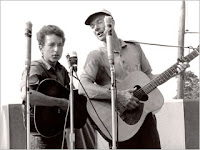
Phil Ochs
George Myers, Jr., Westerville, OhioI was attending the Royal University of Nairobi in 1973 and, on a green wooded hill a mile away, sharing a two-man room in the YMCA. One day a heavy-set man announced himself from the doorway, bougainvillea in bloom behind him on a makeshift trellis. He strode in, dragging an army surplus bag and a guitar, and dropped wearily on the cot facing me. He wore a funny blue cap, like a beret maybe, and fatigues. The army jacket was too warm for the weather. In my thinking about it I missed his name.
Pushed by indifference, the man reached into his duffel bag, withdrew a book or album and tossed it to me. It was
The Phil Ochs Songbook. The man was Phil Ochs, folksinger and songwriter, author of any number of small hits from the sixties. He was disturbed I didn’t recognize his name at the outset, but was pleased that I eventually did. I was twenty, not yet into my time. His time had passed, he said. Over the next three weeks he would say that the past was a terrible burden on him, that the ‘movement’ was dead, that there were no more issues, no more dragons to slay.
Ochs had just been mugged and beaten up by robbers in Tanzania and he was working his way through Kenya, sore throat, guitar and dungarees. Ochs said he was looking for a cause, to be ‘reignited,’ as he said it. He had set up a recording session at an EMI-affiliated studio in Nairobi and did produce, after much translation problems, a two-sider to be played on local jukeboxes, and it was after that he moved on.
My favourite memory of Ochs was when we attended
Once Upon a Time in the West for the second time at a rundown old movie house in Nairobi. The Jason Robards-Henry Fonda film was his favourite, he said, and he knew its scenes forward and backward. The locals, however, did not. About two hours into the picture, the projectionist goofed up the order of the reels and played the finale too soon, and then continued with the out-of-order reel. I could understand a little Swahili by that time and could hear that no one in the audience seemed to notice, or care. The fact that one man could be shot and killed, then rise up again alive seemed perfectly okay to everyone.
Ochs was enraged, at first. He left his seat to talk to the projectionist and came back happy. I asked him what happened. ‘You’ll see,’ he said. And I did see, for another three hours. He talked the projectionist into playing the reels in the right order. By lengthening the film to a marathon five-plus hours, we could watch Fonda live, be killed off, live again and then die a second time around. No one thought anything amiss, from what I could tell. Ochs was particularly pleased; he was laughing.
 By Tom Harrison, The Province
By Tom Harrison, The Province



